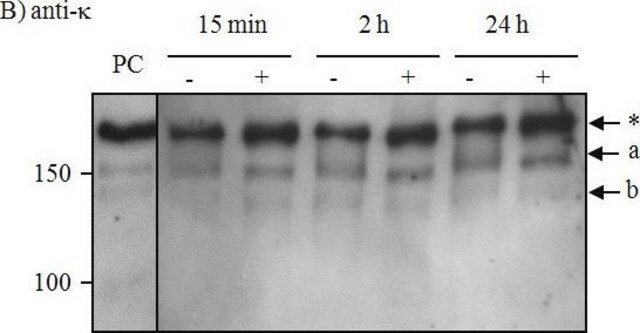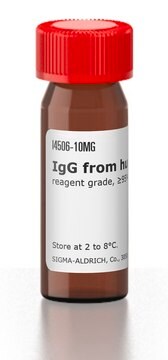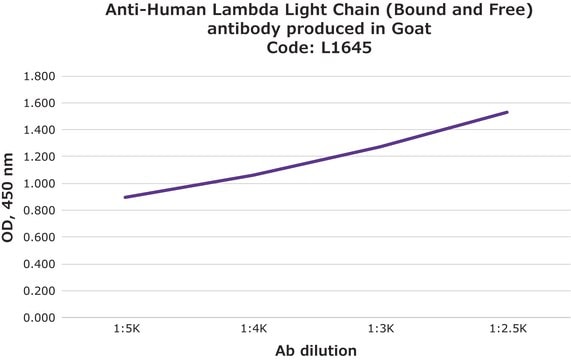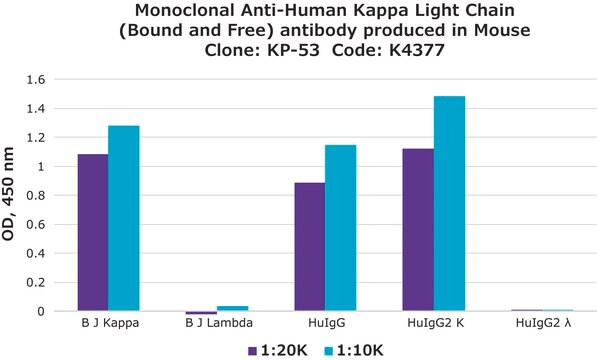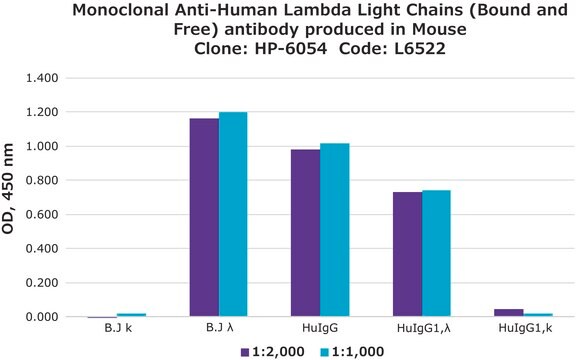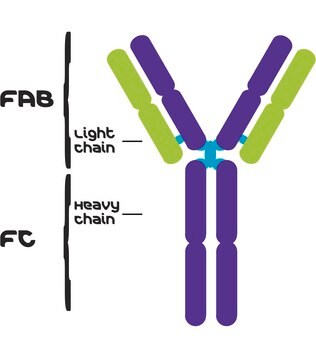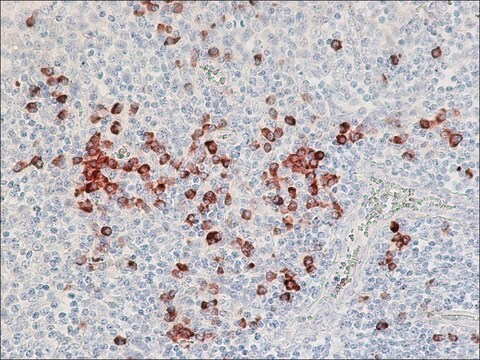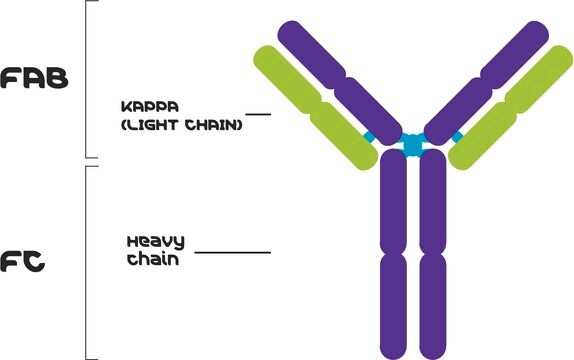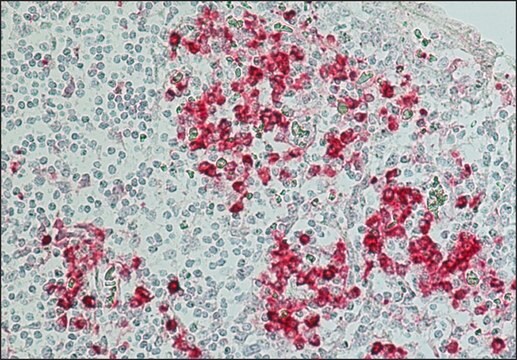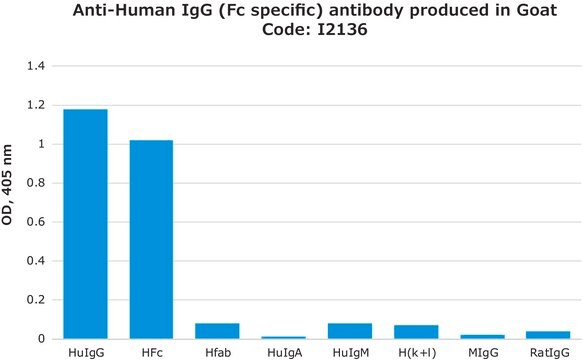Wszystkie zdjęcia(1)
Kluczowe dokumenty
K3502
Anti-Human Kappa Light Chain (Bound and Free) antibody produced in goat
affinity isolated antibody, lyophilized powder
Zaloguj sięWyświetlanie cen organizacyjnych i kontraktowych
About This Item
Polecane produkty
pochodzenie biologiczne
goat
Poziom jakości
białko sprzężone
unconjugated
forma przeciwciała
affinity isolated antibody
rodzaj przeciwciała
secondary antibodies
klon
polyclonal
Formularz
lyophilized powder
metody
quantitative precipitin assay: suitable
temp. przechowywania
2-8°C
docelowa modyfikacja potranslacyjna
unmodified
informacje o genach
human ... IGK@(50802)
Szukasz podobnych produktów? Odwiedź Przewodnik dotyczący porównywania produktów
Opis ogólny
Anti-Human κ Light Chain (bound and free) antibody is obtained from goat antiserum. Immunospecific purification removes all goat serum proteins and immunoglobulins that do not bind to the κ light chain (bound and free). The antibody preparation is specific for κ light chains when tested against bound and free light chains. The product shows no reaction with bound or free λ light chains.
Immunogen
Purified human normal and myeloma κ light chain
Zastosowanie
Anti-Human κ Light Chain (Bound and Free)-FITC antibody was used for as secondary antibody in ELISA at a working antibody dilution of 1:200 using maize seed extracts. For ELISA using NSO/1 myeloma cells, HEK293 cells and mouse plasma, antibody concentration of 1-2 μg/ml was used. The antibody was also used to coat the electrode surface in the preparation of antiatrazine immunosensor.
Anti-Human Kappa Light Chain (Bound and Free) antibody produced in goat has been used in western blotting.
Postać fizyczna
Lyophilized from 0.01 M sodium phosphate, 0.015 M sodium chloride, pH 7.2
Rekonstytucja
Reconstitute with 0.135 M sodium chloride.
Oświadczenie o zrzeczeniu się odpowiedzialności
Unless otherwise stated in our catalog or other company documentation accompanying the product(s), our products are intended for research use only and are not to be used for any other purpose, which includes but is not limited to, unauthorized commercial uses, in vitro diagnostic uses, ex vivo or in vivo therapeutic uses or any type of consumption or application to humans or animals.
Ta strona może zawierać tekst przetłumaczony maszynowo.
Nie możesz znaleźć właściwego produktu?
Wypróbuj nasz Narzędzie selektora produktów.
Wybierz jedną z najnowszych wersji:
Masz już ten produkt?
Dokumenty związane z niedawno zakupionymi produktami zostały zamieszczone w Bibliotece dokumentów.
Klienci oglądali również te produkty
Characterization of immunological interactions at an immunoelectrode by scanning electron microscopy
Ambrosi A et al
Electroanalysis, 19, 244-252 (2007)
Yvonne J Rosenberg et al.
PloS one, 11(3), e0152760-e0152760 (2016-04-01)
Intravascular delivery of broadly neutralizing antibodies (bnAbs) has shown promise for prevention and treatment of HIV infection. However, multiple IV administrations in geographic locations with poor accessibility to medical care have practical limitations. We have assessed the efficacy of plant-derived
Yvonne Rosenberg et al.
PloS one, 8(3), e58724-e58724 (2013-03-28)
Passive immunotherapy using anti-HIV broadly neutralizing monoclonal antibodies (mAbs) has shown promise as an HIV treatment, reducing mother-to-child-transmission (MTCT) of simian/human immunodeficiency virus (SHIV) in non-human primates and decreasing viral rebound in patients who ceased receiving anti-viral drugs. In addition
Ruben J Boado et al.
Biotechnology and bioengineering, 96(2), 381-391 (2006-08-29)
A murine monoclonal antibody (MAb) to the human insulin receptor (HIR) has been engineered for use as a brain drug delivery system for transport across the human blood-brain barrier (BBB). The HIRMAb was humanized by complementarity determining region (CDR) grafting
S M Chamow et al.
Journal of immunology (Baltimore, Md. : 1950), 153(9), 4268-4280 (1994-11-01)
HIV infection depletes the immune system of the coordinating functions of CD4+ T cells and APCs, whereas the population of CD8+ CTLs remains largely intact: functional but undirected. We have developed a humanized bispecific immunoadhesin-antibody (BIA) that redirects these remaining
Nasz zespół naukowców ma doświadczenie we wszystkich obszarach badań, w tym w naukach przyrodniczych, materiałoznawstwie, syntezie chemicznej, chromatografii, analityce i wielu innych dziedzinach.
Skontaktuj się z zespołem ds. pomocy technicznej